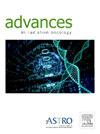使用单能量质子原始布拉格峰传递技术的FLASH立体定向全身放射治疗脊柱肿瘤
IF 2.7
Q3 ONCOLOGY
引用次数: 0
摘要
目的探讨Bragg峰闪烁(BP-FLASH)在脊髓立体定向放射治疗(SBRT)中的剂量学性能和剂量率。方法与材料选择10例连续接受常规调强质子治疗(cv - impt) SBRT(5次40 Gy)治疗的脊柱肿瘤患者。这些患者使用内部FLASH算法和单能量布拉格峰方法进行重新优化。比较了靶覆盖和关键危险器官(OARs)的剂量分布和剂量计量。BP-FLASH计划使用平均剂量率计算剂量率。以0.2、2和5 Gy的剂量阈值评估闪速比(V40Gy/s)。取10例患者的剂量和剂量率的平均值,比较convt - impt和BP-FLASH进行t检验。结果剂量学分析显示,BP-FLASH方案对关键桨叶的剂量与convt - impt方案相似。然而,在BP-FLASH中,临床靶体积的最大剂量高于convt - impt(115.1%比108.9%,P = .001)。脊髓(P = 0.122)和食道(P = 0.327)的最大剂量无显著差异。所有OARs的FLASH剂量率均超过80%,剂量阈值为2 Gy。当增加到5 Gy时,V40Gy/s增加到复合剂量的95%。结论sbp -FLASH SBRT是一种很有前景的治疗挑战性脊髓癌的方法,它实现了超高剂量率的FLASH效果,并保持了与convt - impt计划相同的剂量学质量。本文章由计算机程序翻译,如有差异,请以英文原文为准。
FLASH Stereotactic Body Radiation Therapy for Spine Tumors Using a Single-Energy Proton Pristine Bragg Peak Delivery Technique
Purpose
To investigate the dosimetric performance and dose rate of Bragg peak FLASH (BP-FLASH) for spinal cord stereotactic body radiation therapy (SBRT).
Methods and Materials
Ten consecutive patients with spinal tumors treated with conventional intensity modulated proton therapy (CONV-IMPT) SBRT (40 Gy in 5 fractions) were selected for this study. These patients were reoptimized using an in-house FLASH algorithm and a single-energy Bragg peak approach. The dose distributions and dose metrics for target coverage and critical organs-at-risk (OARs) were compared. BP-FLASH plans dose rates were calculated using an average-dose-rate. The FLASH ratios (V40Gy/s) were assessed with dose thresholds at 0.2, 2, and 5 Gy. The doses and dose rates for the 10 patients were averaged, and a t test was performed comparing CONV-IMPT and BP-FLASH.
Results
Dosimetric analysis revealed that the BP-FLASH plans deliver a similar dose as CONV-IMPT plans to critical OARs. However, in BP-FLASH, the clinical target volume received a higher maximum dose than CONV-IMPT (115.1% versus 108.9%, P = .001). No notable differences were observed in the maximum doses to the spinal cord (P = .122) or esophagus (P = .327). FLASH dose rates for all the OARs exceeded 80% with 2 Gy dose threshold. When increased to 5 Gy, V40Gy/s increased to >95% for composite plan doses.
Conclusions
BP-FLASH SBRT is a promising treatment for challenging spinal cord cancers, which achieved ultra-high-dose rates for FLASH effect and maintained the same dosimetry quality as the CONV-IMPT plans.
求助全文
通过发布文献求助,成功后即可免费获取论文全文。
去求助
来源期刊

Advances in Radiation Oncology
Medicine-Radiology, Nuclear Medicine and Imaging
CiteScore
4.60
自引率
4.30%
发文量
208
审稿时长
98 days
期刊介绍:
The purpose of Advances is to provide information for clinicians who use radiation therapy by publishing: Clinical trial reports and reanalyses. Basic science original reports. Manuscripts examining health services research, comparative and cost effectiveness research, and systematic reviews. Case reports documenting unusual problems and solutions. High quality multi and single institutional series, as well as other novel retrospective hypothesis generating series. Timely critical reviews on important topics in radiation oncology, such as side effects. Articles reporting the natural history of disease and patterns of failure, particularly as they relate to treatment volume delineation. Articles on safety and quality in radiation therapy. Essays on clinical experience. Articles on practice transformation in radiation oncology, in particular: Aspects of health policy that may impact the future practice of radiation oncology. How information technology, such as data analytics and systems innovations, will change radiation oncology practice. Articles on imaging as they relate to radiation therapy treatment.
 求助内容:
求助内容: 应助结果提醒方式:
应助结果提醒方式:


